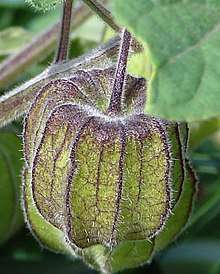Physalis infinemundi
| Physalis infinemundi | |
|---|---|
 | |
| The fossil imprint greatly resembles this cape gooseberry fruit, except with a calyx of fewer segments, and the end open to expose the fruit. | |
| Scientific classification | |
| Kingdom: | Plantae |
| Clade: | Angiosperms |
| Clade: | Eudicots |
| Clade: | Asterids |
| Order: | Solanales |
| Family: | Solanaceae |
| Genus: | Physalis |
| Species: | P. infinemundi |
| Binomial name | |
| Physalis infinemundi Wilf | |
Physalis infinemundi is the name assigned to a fossil estimated to be 52 million years old, of what appears to be a Physalis closely resembling the Cape gooseberry fruit, popularly described as a fossil tomatillo.[1] "Infinimundi" means "end of the earth" referring to the location of the fossil in the south of Argentina, one of the southernmost normally-populated points on the earth.
The fossil
Found in Patagonia, the fossil's radiometric dating arrived at an age of 52 million years. This is 12 million years older than the estimates based on molecular dating, which assumes that mutations occur at an almost exact interval, so that differences between related plants show when they diverged. Once presented as with almost clockwork in precision, the latter dating method has increasingly been shown to be far less precise than once claimed.[2]
The fossil shows an imprint resembling a plant stem and fruit. The "fruit" is partially covered by about five lobes, the sepals of the original flower bud. This pattern seems almost identical to the genus now described for this fossil, Physalis, which includes tomatillos and ground cherries, the latter being what the fossil resembles most closely.[3]
Based on the location of the fossil, and other evidence around it, the plant is thought to have existed in a temperate rain forest near a mountain, before the breakup of the last "super continent" thought to have existed, Gondwanaland.
References
- ↑ Angus Chen (10 January 2017). "52 Million-Year-Old Tomatillo Fossils Rewrite Veggie History". National Public Radio, Inc. Retrieved 5 October 2018.
- ↑ Donoghue, Philip C. J.; Lyson, Tyler R.; Joyce, Walter G.; Parham, James F.; Warnock, Rachel C. M. (2015). "Calibration uncertainty in molecular dating analyses: there is no substitute for the prior evaluation of time priors". Proceedings. Biological sciences Royal Society (Great Britain). The Royal Society. 282 (1798).
- ↑ Wilf, Peter; Carvalho, Mónica R.; Gandolfo, María A.; Cúneo, N. Rubén (2017). "Eocene lantern fruits from Gondwanan Patagonia and the early origins of Solanaceae". Science. American Association for the Advancement of Science. 355 (6320): 71–75.